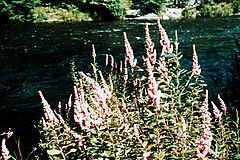Spiraea tomentosa
| Habit | shrub
| |
|---|---|---|
| Height: | ⇕ | 7 ft"ft" can not be assigned to a declared number type with value 7. |
| Width: | ⇔ | 7 ft"ft" can not be assigned to a declared number type with value 7. |
| Lifespan: | ⌛ | perennial |
| Bloom: | ❀ | early summer, mid summer, late summer |
| Exposure: | ☼ | sun |
|---|---|---|
| Features: | ✓ | flowers |
| USDA Zones: | 4 to 10 | |
| Flower features: | ❀ | red, pink |
|
Rosaceae > |
Spiraea > |
Spiraea tomentosa, commonly known as the Steeplebush, is a plant similar in characteristic to the Hardhack (S. douglasii).
Spiraea tomentosa grows to up to four feet high, and prefers moist to wet soil and full sun. It blooms in summer. Individual Steeplebush flowers are about 1/16 of an inch wide and are arranged in narrow, pyramid-shaped clusters that can be up to eight inches long. Butterflies and other nectar-feeding insects find the flowers highly attractive. The flowers are followed by small, dry, brown fruit.
The hardiness zone for this plant is listed as zones 4 to 6. It is found natively in the eastern United States and Canada.
Read about Spiraea tomentosa in the Standard Cyclopedia of Horticulture
|
|---|
|
Spiraea tomentosa, Linn. Hardhack. Steeplebush. Shrub, 4 ft. high, with upright, brown, tomentose branches: lvs. ovate to oblong-ovate, acute, unequally and often doubly serrate, densely yellowish or grayish-tomentose beneath, 1-2 1/2 in. long: fls. deep pink or purple, in narrow dense panicles, brownish tomentose and 3-8 in. long; stamens somewhat longer than the obovate petals; sepals reflexed: follicles pubescent, usually diverging. July-Sept. Nova Scotia to Ga., west to Man. and Kans. Var. alba, Rehd. (f. albiflora, Macbride). With white fls.—This species does not spread by suckers like most others of the section Spiraria. All the last-named species are valuable as late-blooming shrubs and decorative with their showy panicles of bright or deep pink fls. They appear at their best when planted in masses in the wilder parts of the park in low ground. CH
|
Cultivation
Propagation
Pests and diseases
Varieties
Gallery
References
External links
- w:Spiraea tomentosa. Some of the material on this page may be from Wikipedia, under the Creative Commons license.
- Spiraea tomentosa QR Code (Size 50, 100, 200, 500)

